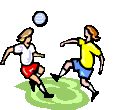O tempo verbal Simple Present corresponde ao Presente do Indicativo em português. Nós o utilizamos para expressar verdades universais, fatos científicosou da natureza. Utilizamos também para falar sobre ações habituais que fazem parte da rotina, repetidas no presente. Neste caso costumamos acompanhar o verbo com advérbios ou expressões de frequência que dão maior especificidade à ideia da frase, como always(sempre), often (frequentemente), never (nunca), every day (todos os dias), sometimes (às vezes) e etc.
Fatos da natureza Ações habituais
The sun rises every day. She works 6 times per week.
(O sol nasce todos os dias.) (Ela trabalha 6 vezes por semana.)
ESTRUTURA DAS SENTENÇAS AFIRMATIVAS
A forma básica da sentença no Simple Present é o verbo no infinitivo, mas sem a partícula to. Essa é a forma para todas as pessoas, exceto para a 3ª pessoa do singular (he/she/it), nessa forma costuma-se acrescentar –s no verbo. Observe:
SIMPLE PRESENT – AFIRMATIVA
|
| TO THINK | TO MAKE |
TO LOVE
|
| I | think | I | make | I | love |
| You |
| You | You |
| He | thinks. | He | makes. | He | loves. |
| She | She | She |
| It | It | It |
| We | think. | We | make. | We | love. |
| You | You | You |
| They | They | They |
Casos especiais
* O 1º caso especial é o verbo TO BE (ser, estar)
Ele já tem a 3ª pessoa especificado.
* O 2º caso especial é o verbo TO HAVE (ter)
Na 3ª pessoa ele perde as duas últimas letras e acrescenta-se S.
| TO BE |
TO HAVE
|
| I | am. | I | have. |
| You | are. | You |
| He | is. | He | has. |
| She | She |
| It | It |
| We | are. | We | have. |
| You | You |
| They | They |
* O 3º caso especial são os verbos terminados em o, ss, ch, sh, x, em que se acrescenta ES:
| O | go (ir) | → |
he/she/it goes
|
| SS | kiss (beijar) | → |
he/she/it kisses
|
| CH | teach (ensinar) | → |
he/she/it teaches
|
| SH | wash (lavar) | → |
he/she/it washes
|
| X | fix (consertar) | → |
he/she/it fixes
|
* O 4º caso especial são os verbos terminados em Y, eles têm 2 possibilidades:
Y precedido de VOGAL acrescenta-se –S
|
| Pay (pagar), buy (comprar) |
He/she/it pays, buys
|
| |
Y precedido de CONSOANTE acrescenta-se –IES
|
| Cry (chorar), try (tentar) |
He/she/it cries, tries
|
ESTRUTURA DAS SENTENÇAS NEGATIVAS
Para escrever uma sentença negativa no Simple Present utiliza-se o verbo auxiliar do + not – mais utilizado na escrita, pois é formal – ou sua forma contracta don’t – mais utilizada na fala, pois é informal – antes da forma básica do verbo sem o to, exemplo:
1- I do not play the piano. (Eu não toco piano.)
2- My parents don’t like TV. (Meus pais não gostam de TV.)
Na 3ª pessoa do singular (he/she/it), usa-se o verbo auxiliar does + not ou doesn’t em vez de do+ notou don’t. Note que o verbo seguinte fica na forma básica sem o to e sem o S, exemplo:
1- She does not speak Portuguese, just Chinese. (Ela não fala português, somente chinês.)
2- Paulo doesn’t eat chocolate. (Paulo não come chocolate.)
Observação: Os verbos auxiliares do e does não tem tradução. Mas quando acompanhado do not, pode-se traduzir por não simplesmente.
ESTRUTURA DAS SENTENÇAS INTERROGATIVAS
Na forma interrogativa do Simple Present utilizam-se os verbos auxiliares do e does antes do sujeito na frase. Note que o verbo fica na sua forma básica sem o to e sem o S, observe o exemplo:
1- Do you like orange juice? (Você gosta de suco de laranja?)
2- Does Mariah like movies? (A Maria gosta de filmes?)
RESUMO DO SIMPLE PRESENT
| AFIRMATIVO | NEGATIVO | INTERROGATIVO |
I work
| I don’t work |
Do I work ...?
|
| You work | You don’t work |
Do you work ...?
|
| He works | He doesn’t work |
Does he work ...?
|
| She works | She doesn’t work |
Does she work ...?
|
| It works | It doesn’t work |
Does it work ...?
|
| We work | We don’t work |
Do we work...?
|
| You work | You don’twork |
Do you work ...?
|
| They work | They don’t work |
Do they work ...?
|
Letícia Martins Côrtes
Colaboradora Mundo Educação
Licenciada em Letras - Inglês pela Universidade Federal de Goiás - UFG
Curso de Aperfeiçoamento em Inglês pelo Centro de Línguas da Universidade Federal de Goiás - UFG
Mestranda em Estudos Linguísticos pela Universidade Federal de Goiás - UFG
http://www.mundoeducacao.com/ingles/simple-present.htm























 She .
She . They .
They .  The chef a meal.
The chef a meal. Pete and Jane TV.
Pete and Jane TV.  He in the sea.
He in the sea.  They football.
They football.  Maggie .
Maggie . Is he playing the piano?
Is he playing the piano?  Are they ice-skating?
Are they ice-skating? 















